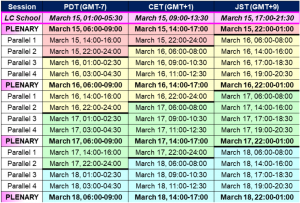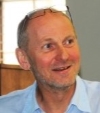
The table showing the session time slots in 3 time zones; Pacific Daylight Time (PDT) – US West Coast
Central European Time (CET) – Geneva
Japan Standard Time (JST) – Tokyo
The 2021 International Workshop on Future Linear Colliders (LCWS2021), arranged by Europe as an online conference with more than 900 registered participants, took place from 15 to 18 March. As earlier conferences in this series it was primarily devoted to the physics, detector, and accelerator studies for the Compact LInear Collider (CLIC) and the International Linear Collider (ILC).
Since the last workshop in the series (LCWS2019), many new international developments have taken place. The European Strategy for Particle Physics (ESPP) Update 2020 places an electron-positron Higgs factory as the highest-priority next-generation collider. A linear collider – CLIC or ILC – will operate as a Higgs factory during its initial stage, while maintaining a clear path for future energy upgrades. The CLIC programme and associated high-gradient R&D for 2021-26 have been defined in accordance with the ESPP outcome.
Preparations for the ILC in Japan have changed gear with the International Committee for Future Accelerators (ICFA) announcing the establishment of the ILC International Development Team (IDT) hosted by KEK. ILC is currently the focus of a general and broad effort in Japan involving several Ministries as well as the Diet, in close connection with industry, academia and the Tohoku region, the potential construction site. This progress has been summarised in a recent document issued by the ILC Steering Panel established under Japan Association of High Energy Physicists (JAHEP). Besides the progress achieved in Japan, 2020 also saw the emergence and focused effort of the IDT towards defining the ILC Pre-Lab programme – a four-year preparatory phase to bring the ILC project to construction readiness, and the organisational structures and processes needed to start the Pre-Lab. In the US, the Snowmass process is on-going with ILC as the most prominent Higgs-factory possibility on the timescale considered.
The LCWS2021 started Monday morning with an online version of the 8th Linear Collider Physics school where some 160 students participated. From Monday afternoon to Thursday afternoon plenary and parallel sessions were used to review the progress on accelerator design for linear colliders, detector developments and physics studies and, equally important, looking ahead towards the next steps. ILC topics were overlapping with similar CLIC activities whenever possible.
The main plenaries were on Monday and Thursday. The Monday plenary session featured reports on technical/scientific aspects on ILC and CLIC, status reports from Japan (KEK, the JAHEP ILC Steering Panel and Tohoku) and North America, and recent progress from IDT. The Thursday plenary included CERN and European perspective talks, an update on the linear-collider-related Snowmass preparation and documentation, and summaries of some of the parallel working group sessions. The Tuesday and Wednesday plenary sessions focused on accelerator and physics & detector studies, respectively.
With a wide programme of 51 parallel sessions, the workshop provided ample opportunities to present ongoing work as well as getting informed and involved. The Physics and Detector parallel sessions alone attracted 144 submitted abstracts. Altogether 292 talks were given during the four days.
Besides these sessions, the programme also included a special ‘New Research and Opportunities Tracks’ to discuss ideas of complementary programmes beyond the ILC Higgs factory (e.g. fixed-target and beam-dump experiments – relevant for example for dark sector physics, lower energy beams for accelerator and detector R&D, irradiation possibilities, electron-laser collisions, etc.). In addition, a session on ‘New Technologies & Ideas for Collider Detectors’ was included. These sessions represent a first step towards ILC Expressions of Interest, and these topics will be further pursued in a dedicated ILC workshop, planned to be held in Tsukuba from 26 to 29 October.
A new feature was a session on advanced and novel accelerator (ANA) technologies prepared by the ICFA-ANA panel. Not only can these technologies be of interest to deploy in the longer term in an LC tunnel to reach multi-TeV energies, but an LC facility can also in the shorter term provide interesting and unique beams and opportunities for developing such novel technologies.
A very interesting session with around 70 participants was devoted to the industrial aspects of the ILC, offering an opportunity to highlight the expertise and innovation capabilities of national laboratories and their related industrial partners for the ILC Pre-Lab activities and the main ILC technologies.
Overall the workshop highlighted the large and increasing international community and efforts pursuing a future linear collider, and the community is now very focused on an ILC Pre-Lab as the immediate next step towards an operational Higgs factory by 2035.
Steinar Stapnes on behalf of – and with sincere thanks to – the Organising Committee


Recent Comments